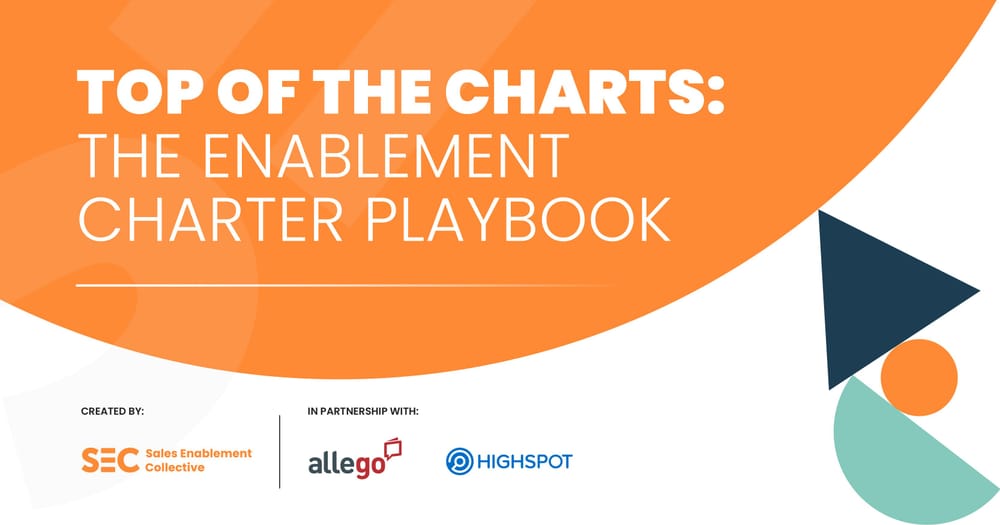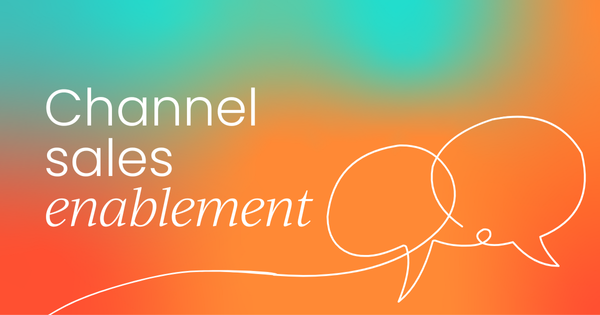What is channel sales enablement?
Channel sales enablement is the process of enabling your channel partners (like resellers, distributors, referral partners, and affiliates) to perform better. Just as, in sales enablement, you help your sales team to sell your products or services effectively, in channel sales enablement, all the same methods apply. You create enablement materials, you hold training sessions, you role-play, and you war game.
All these same approaches can help your channel partners to boost your overall sales figures.
5 reasons why channel enablement is important
1) Faster growth and scalability
You can’t do everything by yourself. Sooner or later, even the best solopreneur will become the bottleneck in their own business. Whether it be due to the number of engaged leads they’re able to get, or their ability to fulfill their service on their own in a way that scales.
Even large companies, once they’re large enough, may find they run into one of these two problems: not enough leads, and an inability to scale fulfillment to the leads they have.
In both of these cases, channel partners can help.
But, without strong channel sales enablement, your channel partners’ results will be hit or miss.

2) Hedging risk
Channel partners – and, by extension, channel sales enablement – are great for hedging against risk.
Channel partners can help you make your cash flow more stable and predictable.
Manufacturers, for example, sell huge volumes of products to distributors and resellers. When these channel partners are effective (again, channel enablement can help with this), they’ll keep coming back. Having a few very large, recurring buyers removes overhead and risk for the manufacturer.
3) Increased market share
Effective channel partnerships will help a business increase its market share in a couple of ways.
First, when two parties collaborate effectively, they’ll spot what the other has missed. The feedback you’ll receive on your products and on your enablement materials will play into this. This helps provide better products and services for your customers, and helps you sell to them more effectively.
Second, you’ll potentially win a place in the minds of members of your partner’s target audience, giving you access to a whole new pool of potential customers.
4) Profitable relationships with others in your space
They say, “If you want to go fast, go alone. If you want to go far, go together.”
Sure, it might sound like a corny phrase from a print hanging on the wall of Mom’s kitchen, but it’s true.
Having a strong network of partnerships helps individuals and businesses go further, be more profitable, and last through tough times. When you look out for them, they’ll do the same for you when you’re in a tough spot.
Since channel sales enablement is such an integral part of how you can support your partners, this plays massively into building and strengthening those relationships.
5) Fresh feedback about your products, services, and enablement materials
New business relationships means new audiences for your products and services. This opens the door to constructive feedback about your solutions from parties with a vested interest in your success.
Since theirs is an outside perspective, there’s a good chance you won’t have heard all of their feedback before, giving you fresh chances to improve your products.
What’s more, if you open up your own B2B sales enablement materials to this audience and their own sellers, you get all the same benefits. New sellers, trying out your enablement materials in new ways, can offer feedback that helps you to improve those materials, even for your own sales teams.
Defining partner enablement as a sales enablement pro
Channel enablement examples
Referral partners
Let’s say you’re a reseller, and you sometimes buy items from a particular product line from another reseller in a similar space. You’re not direct competitors, but you overlap with regard to this product line. Sometimes, you do business with each other.
This would be a great opportunity to set up a referral partnership. When you hear a customer asking for products you don’t sell, but your referral partner does, you can refer those customers to them, and vice versa.
You could agree a referral fee with your referral partner, or you could both simply consider it an investment in your future relationship – a good will gesture. Then, if you’re ever in a pinch, and you need some of the stock they sell, they might be more agreeable to offering you a discounted rate, or a constant flat rate.
In this instance, you are the referral partner to these brands, so they could enable you by:
- Setting up a distribution agreement with you, whereby your customers get free express shipping, so your customers are more likely to choose their products over any competitor’s, so they can get started sooner.
- They could also educate you about their products, or give you access to their own sales enablement material to make it easier for you to upsell their products once you’ve sold your services.
Affiliate partners
Here’s a simple B2C affiliate example. Let’s say you sell weight loss products. When people sign up with you, you could fill a shopping cart with the things they’ll need to get started:
- Workout apparel.
- Running shoes.
- Supplements.
- Resistance bands and weightlifting straps.
Your clients need recommendations, and you tend to give the same ones, for products you trust, each time.
You’re sending these brands customers. Do enough volume, and that referral traffic becomes valuable to those brands. This is a perfect time to reach out and strike up an affiliate partnership with each of them.
To enable channel sales with your affiliate channel partners:
- They could incentivize you by giving you a kickback for each purchase one of your clients makes, via an affiliate link or code, with a larger reward upon reaching certain milestones, like when your link is used 100 times.
- You could use different links for different types of customers to tell your partners which market segment they belong to. Then they can tailor their messaging to the different types of leads you send them.
Resellers
Resellers purchase goods from other resellers, wholesalers, and distributors, and tend to sell either to consumers or other resellers.
Resellers typically offer customer service to the end user, and advise users during the sales process on the best products and solutions for them. They’ll negotiate prices, market the products, and educate consumers about products.
Let’s say you’re a manufacturer of Wi-Fi hardware. Resellers buy your products and sell them on to the end user. Those resellers are your channel partners, and it’s in your best interests that they:
- Understand how your products work.
- Are able to effectively communicate their benefits to customers.
- Know your product lines intimately enough to suggest better options to customers who might be less familiar.
To enable channel sales with your resellers, you could:
- Hold training days for reseller reps.
- Create product line cheat sheets that give salespeople all the information they need to sell effectively at a glance.
- Provide them with rules for messaging, so their sales reps and marketers speak about, and produce content about, your products that’s on-brand.
OEM (original equipment manufacturers)
Big brand names can’t produce perfect products all the time. Sometimes, they produce products that don’t make the cut.
Rather than risk selling substandard products to their customers and damaging their brand reputation, they can minimize the loss they make on these products by selling them to another company, who can then sell them on as their own products.
This company might not have as much invested in its brand name. Or, it might have a business model that allows it to sell the faulty products’ parts for a premium to the right buyer. Buyers the original manufacturer might not have the time or inclination to source and sell to.
When I worked for a tech hardware distributor, they took on a new range of IP security cameras from a well-known brand (who we’ll call Brand 1), though known for household appliances, rather than cameras.
Interestingly, these cameras were OEM – the original manufacturer (who we’ll call Brand 2) being one of the largest names in the security camera space.
This allowed Brand 1 to branch out into a new product category, while developing and selling their own software for those hardware cameras, while it gave Brand 2, the OEM, a new large buyer for their products.
5 tips for implementing a channel enablement strategy
Working with partners can be profitable, but it brings its own set of challenges. Here are five tips for getting it right:
- Focus on the needs of your channel partner
- Lead from the front
- Incentivize partner performance
- Provide enablement materials
- Hold joint sales training sessions
1) Focus on the needs of your channel partner
“Seek first to understand, then to be understood.”
Whenever you’re faced with a challenge in your professional (or personal!) relationships, it helps to focus first on understanding the needs of the other party.
Accurately communicating their needs back to them:
- Gives them a sense of relief
- Makes them feel understood
- And puts them at ease.
They feel you’re on their side, and that you share a common understanding.
Once you’ve demonstrated that you understand the needs of your channel partner, they’ll be much more receptive to hearing, and acting in favor of, your needs too.
2) Lead from the front
Following on from point one, make sure you’re supporting your channel partners as much as you’d like them to support you. Help them grow, and they’ll likely follow suit.
Don’t be afraid to lead the charge here. The more value you can give them, the more you’ll trigger reciprocity, and give them ideas as to how they can help you in return.
Don’t wait for them to do something before you act. Assume reciprocity, throw yourself into the partnership, and get to work showing value, and you’ll reap the rewards many times over.
3) Incentivize partner performance
If you want a more concrete guarantee that your partners will help you in return for your efforts, incentivize them as part of your partner enablement program.
Usually, channel partner incentives take the form of financial rewards, offered in return for hitting certain goals.
You see this all the time with referrals. Partners might get a small incentive per referral, but a larger bonus if at least five referred leads convert within a month.
This gamifies the referral process, and motivates your partner to do more work on your behalf.
4) Provide (quality) enablement materials
Resellers are just one group that’ll benefit hugely from having access to your enablement materials.
The more value you can provide with these, the better. Again, there’s a higher upfront cost to produce them, but you’ll trigger reciprocity while boosting their performance.
Here’s an example.
Let’s say you manufacture hardware for computer servers. Your products are technical, and take some time to understand. Your product lines are large, too, making it a big job for sales reps to correctly recall the specifications for each product, and its specific benefits.
If you have a reseller that’s underperforming, do the work to find out where they’re struggling. If their reps don’t have the time to familiarize themselves with everything in your product line, it’s worth your time to create cheat sheets, and other enablement materials.
These will make it easier for reps to find information on your products, and speak about them accurately and authoritatively on sales calls, without having to spend time learning about them.
5) Hold joint sales training sessions
Train your channel partners’ teams on your products, their benefits to the customer, and the sales approaches that have already worked well for you.
After all, while they might be entirely new to your brand, you’ve been successfully selling your products for a while. You’ve got subject-matter experts who can explain how your products work, and what their benefits are.
To be more efficient, invite your channel partners to sales training days you hold for your own team, and make it as easy as possible for them to attend. Incentivize them to attend, if you have to, since the better they do, the more you’ll increase sales, and the better your business will do as a result.
Conclusion
Partnerships can be difficult.
All of a sudden, there are more parties to please, and more considerations to make at each stage.
Managing partner relationships well takes investment. When things get tough, think of the benefits you’ll reap into the future from investing in strong, relationships with others in your space that trigger growth.
Remember that, with a strong channel partner program, you’re hedging risk, increasing your market share, and ensuring faster growth for your business.
Next steps: Build your enablement charter
If you want to truly take your channel partnerships to the next level, you'll need an enablement charter.
Your enablement charter is one of the highest ROI documents you can produce as an enabler. But to make one, you first need to know how.
The Enablement Charter Playbook walks you through:
- Exactly what an enablement charter is (and what it’s not), so you can create one the right way from the start. ✅
- Pro tips and tactics for keeping your charter up-to-date, without it taking you hours a week. ⌛
- An easy-to-use template to give you a headstart in creating your own charter with confidence. 🛠️
The playbook costs you nothing. We just need to know where to send it. Fill in the form to get yours.👇



Sales enablement insider
Thank you for subscribing
Level up your sales enablement career & network with sales enablement experts
An email has been successfully sent to confirm your subscription.
 Follow us on LinkedIn
Follow us on LinkedIn


.png)




